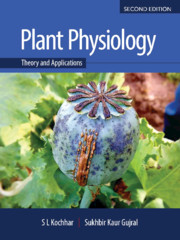Book contents
- Frontmatter
- Contents
- Foreword
- Preface to the Second Edition
- Preface to the First Edition
- Acknowledgements
- Some Common Abbreviations used in the Text
- Abbreviations for Units
- Unit I Water and Mineral Translocation in Plants
- Unit II Metabolism and Bioenergetics
- Unit III Growth and Development
- Unit IV Physiological Stress and Secondary Metabolites – Their Role in Metabolism
- Unit V Crop Physiology – An Innovative Approach
- Unit VI Breakthroughs in Plant Physiology
- Unit VII Some Experimental Exercises
- Glossary
- References
- Index
- Colour Plates
Chapter 4 - Mineral Nutrition and Absorption
Published online by Cambridge University Press: 12 May 2020
- Frontmatter
- Contents
- Foreword
- Preface to the Second Edition
- Preface to the First Edition
- Acknowledgements
- Some Common Abbreviations used in the Text
- Abbreviations for Units
- Unit I Water and Mineral Translocation in Plants
- Unit II Metabolism and Bioenergetics
- Unit III Growth and Development
- Unit IV Physiological Stress and Secondary Metabolites – Their Role in Metabolism
- Unit V Crop Physiology – An Innovative Approach
- Unit VI Breakthroughs in Plant Physiology
- Unit VII Some Experimental Exercises
- Glossary
- References
- Index
- Colour Plates
Summary
Plants contain 80–90 per cent of water by weight and the remaining 10–20 per cent is dry matter. Nearly 95 per cent of the dry matter is comprised of carbon, hydrogen and oxygen. Carbon and oxygen are obtained from the atmosphere in the form of carbon dioxide and water vapour, and hydrogen being derived from water absorbed by the roots from the soil. All other minerals are obtained from the soil. Dry matter when burnt at high temperature (400–500°C) in a muffle furnace, leaves behind non-volatile residue, commonly called plant ash, i.e., metal oxides. The ash content of different plants and tissues varies from 1 to 4 per cent of fresh weight – being the least in aquatic plants and the highest in plants growing in saline or dry soil. Succulent tissues and fleshy fruits are poor in mineral proportion, whereas the leaves contain a relatively high proportion. A careful chemical analysis of the ash reveals that it is made up of as many as sixty different mineral elements found in the plants.
For the actual recognition and the dependence of plants on mineral elements present in the soil, credit must be given to de Saussure. In his book Recherches chimiques sur la végétation, published in 1804, de Saussure clearly demonstrated that the inorganic minerals present in the ash of plants are obtained from the soil through the root system. He further stated that mineral elements, including nitrogen, derived from the soil were important for the growth and development of plants. But the essentiality of the inorganic constituents of plant ash to the general welfare of the plant was not recognized until it was reported by Liebig in 1840.
The earliest kinds of experiments to study mineral nutrition and soil improvement were done in the field. In 1843, the oldest existing Rothamsted Experimental Station, Harpenden, in Hertfordshire, UK was established by Sir John Lawes and John Gilbert. Together they established the first protocols for the extensive experimentation that followed on mineral nutrition of plants and were able to successfully convert insoluble rock phosphate to soluble phosphate(superphosphate).
- Type
- Chapter
- Information
- Plant PhysiologyTheory and Applications, pp. 100 - 150Publisher: Cambridge University PressPrint publication year: 2020

